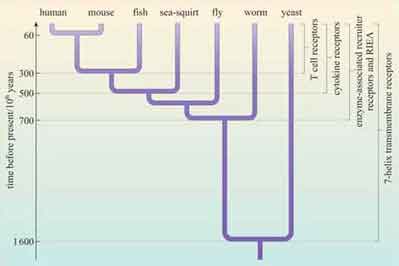From an evolutionary perspective (Figure 5), 7TM receptors are of ancient origin and to date have been found in all eukaryotic genomes that have been sequenced, including yeast (a type of 7TM receptor mediates the yeast mating response described in Section 1.2 and Figure 1). Receptors with intrinsic enzymatic activity and many recruiter receptors are found in C. elegans, D. melanogaster and chordates but not yeast, whereas some recruiter receptors, such as T cell receptors that mediate immune responses, are specific to vertebrates (others such as cytokine receptors are specific to chordates, including all vertebrates and some invertebrates such as the sea-squirt).

Figure 5 Evolutionary origins of plasma membrane receptors. Receptor families are presented in order of their presumed appearance during evolution. (RIEA = receptors with intrinsic enzymatic activity.)
In addition to the four groups of cell-surface receptors shown in Figure 4, another group of receptors function as DNA-binding molecules, and thus regulate gene transcription (these are called receptors with intrinsic transcriptional activity; do not confuse with RIEAs). Some of these receptors are on the cell surface, but most are intracellular (Section 3.5), and require ready access of the ligand to the intracellular compartment.
-
What sort of ligand might act on an intracellular receptor?
-
Signalling molecules that can readily diffuse through the cell membrane. These include lipid-soluble compounds such as steroid hormones, and small diffusible molecules such as NO.
